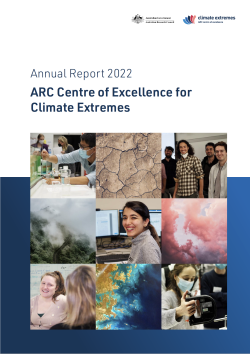Marine heatwaves and mesoscale (~10–100 kilometres) ocean physics profoundly impact the marine environment. They affect ocean physical properties like temperature, mixing, eddies and fronts. These processes, in turn, affect plant and animal physiology and nutrient availability, with consequences at all levels of the ocean food chain. Marine heatwaves also interact with atmospheric physics, while ocean biology and chemistry are at the core of the carbon cycle, with consequences for future climate trajectories.
The Ocean Extremes research program at the ARC Centre of Excellence for Climate Extremes answers the following questions:
PROJECT 1
Marine heatwaves: How can we best model and predict marine heatwaves?
PROJECT 2
Biogeochemistry: What are the current and future roles of mesoscale physics and biogeochemistry in the climate system?
Several PhDs were completed in the Ocean Extremes program in 2023, highlighting the energy, productivity, and global reach of our student cohort.
Dr Nicholas Pittman used a combination of observations and models to investigate variability in the flow of carbon through the equatorial Pacific. Dr Pittman is now working at Emmi, a company that helps investors understand the carbon footprint of their portfolio.
Dr Guillaume Liniger investigated the biological productivity of one of the ocean’s most extreme environments — Antarctic polynyas — and has now taken up a research position at the Monterey Bay Aquarium Research Institute in California, working in the global biogeochemical Argo project. Dr Clara Vives also used biogeochemical Argo floats in her work on Southern Ocean plankton blooms, and she is now a research associate at the University of Copenhagen. Dr Stephy Libera submitted her PhD thesis in April and flew to Belgium to begin a postdoctoral research position at Universitè Catholique de Louvain. Dr Libera’s PhD on sea ice/ocean interactions is highly relevant to recent Antarctic marine heat waves.
Dr Zeya Li examined sea surface temperature anomalies and marine heatwaves along Australia’s east and west coasts and the eastern Pacific rim in terms of El Niño Southern Oscillation modulation. As a recent graduate, she now works for CSIRO in Perth on machine learning techniques to improve marine heatwave prediction.
Our ongoing students continue to make important contributions to the field. Denisse Fierro-Arcos combined physical and biological observations and modelling results for ecological applications, including sharing her code. Catherine Gregory investigated and identified important atmospheric drivers of Tasman Sea marine heatwaves as a step toward better understanding sub-seasonal-to-seasonal time scale marine heatwave predictability. Yuxin Wang has examined the predictability of marine heatwaves off Western Australia and found that the positive Indian Ocean Dipole and La Niña provide multi-month lead time predictability for this region.
Our research associates and senior researchers have also been productive in the science and policy realms. Examples include publishing in discipline journals on Indian Ocean eddies and Southern Ocean carbon cycling, producing a Briefing note on ocean biogeochemistry, contributing to submissions to the Australian Government Climate Change Authority and sharing our analysis tools with the climate science community.
A Centre-sponsored and targeted marine heatwave workshop involving 12 expert participants from Australia and overseas was held at Moreton Island, Queensland, from 23–25 May 2023. The workshop aimed to address the following questions: What are the key mechanisms and scales that will improve knowledge of marine heatwave predictability and prediction? The workshop explored dynamically characterising marine heatwaves, the importance and types of subsurface marine heatwaves and the essential ingredients of a good marine heatwave forecast.

RESEARCH SNAPSHOT

For the last year and final chapter of her PhD, Dr Vives was at the University of Copenhagen in Denmark. Her PhD was focused on understanding how plankton blooms vary across the Southern Ocean — where plankton blooms mean intense accumulations of the photosynthetic, microscopic plants at the base of the marine food chain. They are crucial for ecosystem health, including the abundance of krill and whales, and they play a significant role in the uptake of carbon by the ocean.
Dr Vives used Biogeochemical-Argo floats to show that seasonal changes in light and sea ice are major causes of variability in the timing of these blooms. However, the answer differs depending on whether we measure the bloom using chlorophyll or carbon or nitrogen as an indicator. This has important implications for how we observe Southern Ocean biology, but also tells us how plankton physiology operates in the extreme environment of the Southern Ocean.
In the final part of her PhD research, Dr Vives again used biogeochemical-Argo floats to see how measures of ocean productivity change depending on the subsurface distribution of plankton and if they accumulate in dense layers near nutrient sources around 100 metres depth. At the University of Copenhagen Dr Vives is using her Centre of Excellence training to study how Greenland glacier sediments can be used for ocean enrichment and ocean alkalinity enhancement.
Vives, C.R., Schallenberg, C., Strutton, P.G. and Boyd, P.W. (2023), Biogeochemical-Argo floats show that chlorophyll increases before carbon in the high-latitude Southern Ocean spring bloom. Limnology and Oceanography Letters. https://doi.org/10.1002/lol2.10322.

ARC Centre of Excellence for Climate Extremes – Annual Report 2023
From the Chair of the Advisory Board
Climate Science Leaders of the Future
Weather and Climate Interactions Research Program
Attribution and Risk Research Program
Ocean Extremes Research Program
Computational Modelling Systems
Governance, Management and our Commitment to Equity, Diversity and Inclusion

